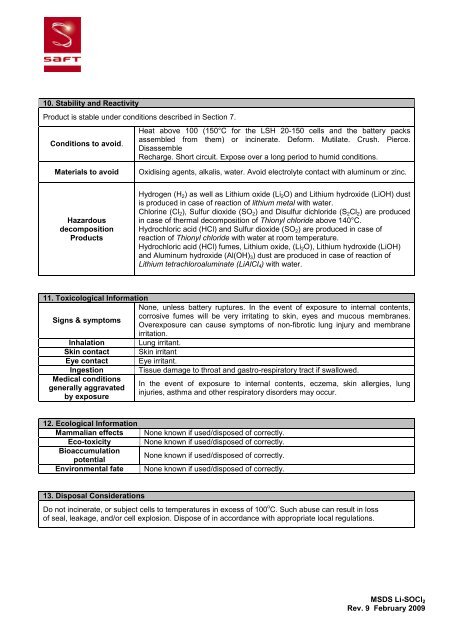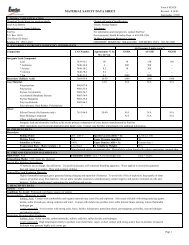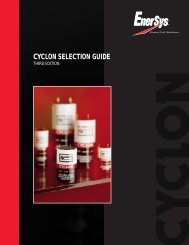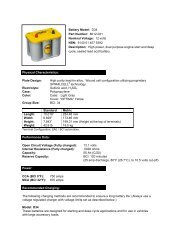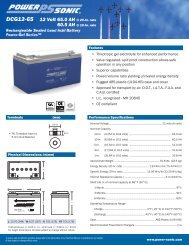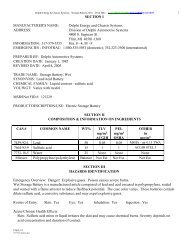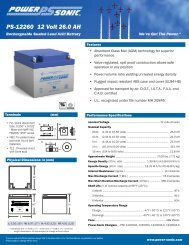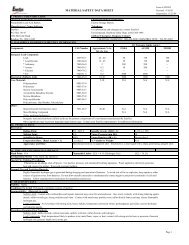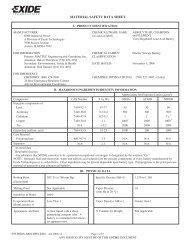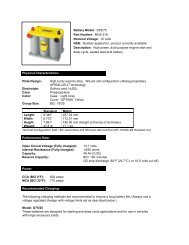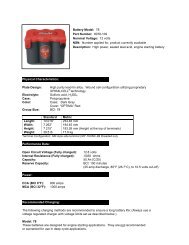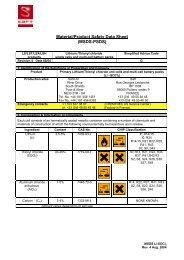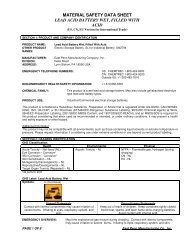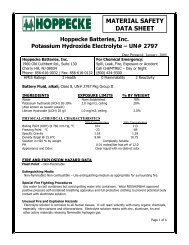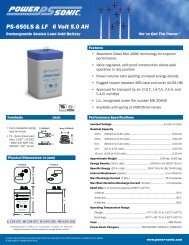SAFT-LS - Battery Web
SAFT-LS - Battery Web
SAFT-LS - Battery Web
Create successful ePaper yourself
Turn your PDF publications into a flip-book with our unique Google optimized e-Paper software.
10. Stability and Reactivity<br />
Product is stable under conditions described in Section 7.<br />
Conditions to avoid.<br />
Heat above 100 (150°C for the <strong>LS</strong>H 20-150 cells and the battery packs<br />
assembled from them) or incinerate. Deform. Mutilate. Crush. Pierce.<br />
Disassemble<br />
Recharge. Short circuit. Expose over a long period to humid conditions.<br />
Materials to avoid<br />
Oxidising agents, alkalis, water. Avoid electrolyte contact with aluminum or zinc.<br />
Hazardous<br />
decomposition<br />
Products<br />
Hydrogen (H 2 ) as well as Lithium oxide (Li 2 O) and Lithium hydroxide (LiOH) dust<br />
is produced in case of reaction of lithium metal with water.<br />
Chlorine (Cl 2 ), Sulfur dioxide (SO 2 ) and Disulfur dichloride (S 2 Cl 2 ) are produced<br />
in case of thermal decomposition of Thionyl chloride above 140°C.<br />
Hydrochloric acid (HCl) and Sulfur dioxide (SO 2 ) are produced in case of<br />
reaction of Thionyl chloride with water at room temperature.<br />
Hydrochloric acid (HCl) fumes, Lithium oxide, (Li 2 O), Lithium hydroxide (LiOH)<br />
and Aluminum hydroxide (Al(OH) 3 ) dust are produced in case of reaction of<br />
Lithium tetrachloroaluminate (LiAlCl 4 ) with water.<br />
11. Toxicological Information<br />
None, unless battery ruptures. In the event of exposure to internal contents,<br />
corrosive fumes will be very irritating to skin, eyes and mucous membranes.<br />
Signs & symptoms<br />
Overexposure can cause symptoms of non-fibrotic lung injury and membrane<br />
irritation.<br />
Inhalation Lung irritant.<br />
Skin contact Skin irritant<br />
Eye contact Eye irritant.<br />
Ingestion Tissue damage to throat and gastro-respiratory tract if swallowed.<br />
Medical conditions<br />
In the event of exposure to internal contents, eczema, skin allergies, lung<br />
generally aggravated<br />
injuries, asthma and other respiratory disorders may occur.<br />
by exposure<br />
12. Ecological Information<br />
Mammalian effects<br />
Eco-toxicity<br />
Bioaccumulation<br />
potential<br />
Environmental fate<br />
None known if used/disposed of correctly.<br />
None known if used/disposed of correctly.<br />
None known if used/disposed of correctly.<br />
None known if used/disposed of correctly.<br />
13. Disposal Considerations<br />
Do not incinerate, or subject cells to temperatures in excess of 100 o C. Such abuse can result in loss<br />
of seal, leakage, and/or cell explosion. Dispose of in accordance with appropriate local regulations.<br />
MSDS Li-SOCl 2<br />
Rev. 9 February 2009


